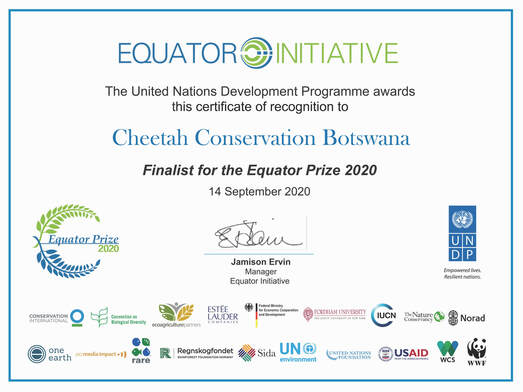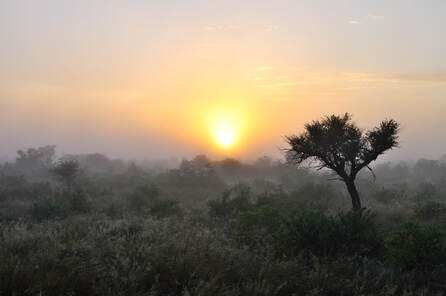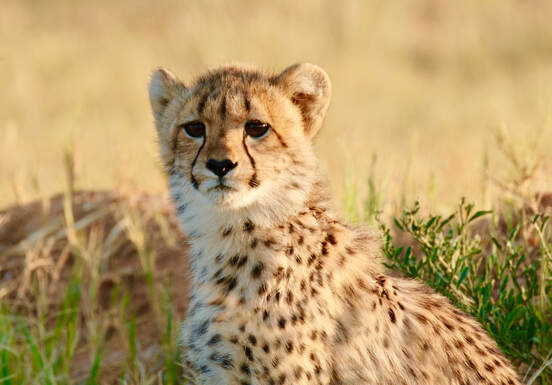For the work we do to be recognized on a global level is an honour. We hope this will continue to motivate our staff and collaborators within communities in the Ghanzi district, our networks of farmers, affiliated schools, and the departments in the government of Botswana we work with to achieve a world where coexistence is a reality.
|
We are proud to announce that CCB has been recognised as a finalist for the Equator Prize 2020. The Equator Prize, organised by the Equator Initiative within the United Nations Development Programme, is awarded biennially to recognize outstanding community efforts to reduce poverty through biodiversity conservation and the sustainable use of natural resource.
For the work we do to be recognized on a global level is an honour. We hope this will continue to motivate our staff and collaborators within communities in the Ghanzi district, our networks of farmers, affiliated schools, and the departments in the government of Botswana we work with to achieve a world where coexistence is a reality.
0 Comments
COVID-19 restrictions pose significant challenges to field research work like that being carried out by CCB’s Marie-Charlotte Gielen. We caught up with her to get some insight on how national precautions have impacted the work she is doing as part of her PhD research.
Marie’s spoor surveys are conducted twice a year over four Wildlife Management Areas (WMAs) of the Ghanzi District, in between the dry and wet seasons. During these periods, the animals tend to move more, some of them switching home ranges between seasons. This is therefore a good opportunity to count their spoor (footprints) and get better insights regarding their movements and their relationships to other landscape features such as cattleposts, vegetation and waterpoints. This year, the spoor survey was planned for mid-May until mid-June. When the lockdown was announced end of March, Marie had some worries that she wouldn’t be able to start her surveys on time and that she would miss some of the wildlife movements. Thankfully, Marie was granted movement permits and was able to start her spoor surveys in early June, only a few week after her original scheduled start date. There was just one problem — “As I looked at the spoor data I collected, the total count was only a quarter of the May 2019 survey. “ she tells us. The number of large carnivores’ spoor that was counted was no different from the survey conducted last year, but the number of large herbivore tracks counted was much lower. Marie believes that there could be several reasons for this. It is possible that because the survey was delayed, a large number of herbivores might have already moved and therefore were not counted. It is also possible that the herbivore populations underwent a severe decline in the populations due to the drought in the area last year. The data seems to indicate that the abundance of cattle in the area may also have deterred the herbivores from the study sites. “I observed cattle tracks on nearly all my transects this season, which I hadn’t observed during the surveys last year.” Marie said. Marie has hypothesised that the good rains that fell late last year resulted in an abundant production of wild melons across the area. When abundant, wild Tsamma melons can serve as an alternative water source for wildlife and livestock alike. This supply of melons may explain why Marie found non-herded cattle wandering upwards of 50km from the nearest cattle post. These cattle had no only strayed from agricultural areas and into the WMA “buffer zones” but it had taken them right up to the southern, unfenced portion of the Central Kalahari Game Reserve. Marie’s data also seems to indicate that most large herbivores tended to avoid all areas where cattle were abundant. It’s possible that wild herbivores do this to avoid the ticks and flies that livestock bring along, as well as avoiding the competition for grazing. These data have important ramifications for the management of livestock in these wildlife management areas as presence of livestock can compromise their role as wildlife corridors. Marie suggests that the adverse effects of livestock in the WMAs could be mitigated efficiently by a time-sensitive implementation of cattle herding to avoid encroachment of the cattle into the wildlife areas and also to reduce human-wildlife conflict at the same time. The consistency and replication of these spoor surveys over seasons are essential to draw out some reliable conclusions on wildlife movements and their interactions with their environment. Marie hopes that the COVID situation will stabilise so that her November survey can be conducted on schedule. The Kalahari is a wild and untouched place. Isolated, arid and generous with wildlife, it has less human impact than almost anywhere else in sub-Saharan Africa. This is the playground for some of the Africa’s most celebrated carnivores, including the vulnerable lions, cheetahs, brown hyaenas and the endangered African wild dogs. An increasing number of people and the subsequent developments that have followed are threatening the still-existing contiguous nature of this wild space. The ancient Kalahari San Bushmen have lived here for time immemorial, posing no threat when they are living harmoniously and sustainably off the land. But the combined forces of eroding traditional lifestyles, the loss of their ancient knowledge of the land and its resources and poorly-managed farming starting to spread into the area threatens one of the world’s largest pristine landscapes. It is here that the Western Kalahari Conservation Corridor links two of the world’s most famed national parks — the Central Kalahari Game Reserve and the Kgalagadi Transfrontier Park. Two large farming communities have sprung up in the middle of this wildlife corridor, squeezing the wildlife around them in three distinct pathways. Two of the three pathways have recently been cut off by newly allocated farmlands and fences. Only one wildlife corridor remains unbroken, with two small communities — Bere and Kacgae — sitting in the center of it. These predominantly San Bushmen communities make for the most natural stewards and gatekeepers of this ecosystem. Their deep and inherent connection with this harsh environment equips them with skills that, if appropriately harnessed and honed, can be used to efficiently manage and benefit from their natural and cultural resource base, and mitigate conflict with wildlife. It is based on this premise that Cheetah Conservation Botswana launched its new Communities for Conservation Programme in 2017. The first step was to understand the communities’ broader development aspirations and then, to see how we, as an organization, can help attain that vision – directly or indirectly, through partnerships. Too often in the past, these communities have been barraged with parachute development schemes — organizations that drop in, conduct workshops, hand out donations, cut and paste interventions from elsewhere and leave almost immediately. We hope to change this tide by being committed to a long-term development strategy that puts the communities themselves in the driver’s seat, acknowledging that this will require time, patience, perseverance, inclusion, participation and collaboration. For the farmers in the region, we have begun engaging them through our “Farming for Conservation” department — continuing our already successful Livestock Guarding Dog Programme with targeted placements in these hot spot conflict areas. Our rapid response units are on hand to deal with conflict situations in the area and have been classified as “essential services”, able to tend to these calls despite COVID-induced ongoing travel restrictions across the country. Our aim is to encourage farmers to farm with as little negative environmental impact as possible by improving veld management and animal husbandry, promoting effective, long-term, non-lethal carnivore management techniques. An area highlighted by the communities as one where they need assistance has been the community trusts, which are the legal vehicles through which they can participate in Community Based Natural Resource Management (CBNRM) related ventures such as eco-tourism, harvesting plants with different medicinal, nutritional and other use values and craft production. Largely redundant after years of stagnation, we hope to grow their capacity so that the community trusts can function effectively by identifying knowledge gaps and institutional challenges and working to address these. Fruitful discussions with various stakeholders have attested the potential for partnerships and exciting developments in this area. Institutional development activities, craft development workshops and veld product harvesting are some of the activities that are slated for the remainder of the year – all subject to the continuously evolving situation with COVID-19. Ultimately, by diversifying nature-based livelihood pathways, communities in the Kalahari can enhance their resilience to the impacts of climate change and utilize innate knowledge of the Kalahari ecosystem to benefit from and conserve this unique wildness for generations to come. This publication was produced with the financial support of the European Union through IUCN Save Our Species. Its contents are the sole responsibility of Cheetah Conservation Botswana and do not necessarily reflect the views of IUCN or the European Union.
|
SearchArchives
May 2024
Categories |




 RSS Feed
RSS Feed
